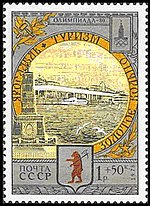| Yaroslavl Uprising | |||||||
|---|---|---|---|---|---|---|---|
| Part of Civil War in Russia | |||||||
| |||||||
| Belligerents | |||||||
|
|
| ||||||
| Commanders and leaders | |||||||
|
|
| ||||||
| Strength | |||||||
|
July 6, 1918: At the end of the uprising: |
July 6, 1918: At the end of the uprising: | ||||||
| Casualties and losses | |||||||
| Unknown |
| ||||||

The Yaroslavl Uprising (known in Soviet historiography as the Yaroslavl Rebellion) was an episode of the Civil War in Russia, an anti–Bolshevik protest by the townspeople and members of Boris Savinkov's organization in Yaroslavl on July 6–21, 1918. Suppressed by the forces of the Workers' and Peasants' Red Army. The uprising began untimely, since the Extraordinary Commission by that moment had begun arresting the Moscow branch of the Union for the Defense of the Motherland and Freedom. This inopportune and inability to coordinate with other anti–Bolshevik forces around the region of the uprising predetermined an unfortunate outcome. The lack of reinforcements and ammunition from the rebels also affected.[citation needed]